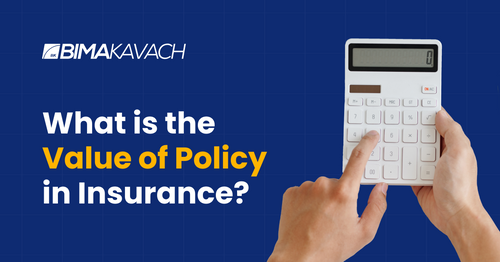In the ever-changing landscape of insurance, where uncertainties and risks are an integral part of our lives, understanding the value of a policy is of prime importance. The value of the policy determines the financial protection that an insurance policy provides to the insured. In this article, we will explore what is meant by the value of policy, why it is important, and how it can be measured.
Understanding the Concept of Policy Value
The "value of policy" in insurance refers to the sum assured or the coverage amount specified in an insurance policy. It represents the maximum amount that an insurance company will pay out in the event of a covered loss or claim. The value of the policy serves as a financial safety net, providing protection to the policyholder against potential financial losses arising from specific risks or perils covered by the insurance policy.
The value of the policy can vary depending on the type of insurance and the specific terms and conditions outlined in the policy document. For example:
In life insurance, the value of the policy is the death benefit that will be paid to the beneficiaries upon the insured person's death.
In health insurance, it represents the maximum coverage for medical expenses, hospitalization, and other healthcare costs.
In property insurance, such as home insurance or car insurance, it reflects the coverage amount for damage to the insured property or liability claims.
In business insurance, it may encompass various aspects, such as property, liability, and business interruption coverage.
Get Free Quote in Minutes
Policy Value in Different Contexts
The value of a policy can also vary depending on the context in which it is being used. For example, the value of a health insurance policy may be different for an individual who is healthy and rarely requires medical attention compared to an individual who has a chronic condition and requires ongoing medical care.
Similarly, the value of a policy may be different for an organization that operates in a high-risk industry compared to an organization that operates in a low-risk industry. In high-risk industries, policies that provide comprehensive coverage and protection against liability claims may have a higher value.
To sum up, the value of a policy is determined by the benefits it offers and the degree to which it meets the needs of the policyholder. The value of a policy can vary depending on the context in which it is being used and the potential risks that the policyholder may face.
Calculating Policy Value
When it comes to insurance policies, the value of a policy is a critical factor that policyholders need to consider. The value of a policy is the amount of money that the policyholder can expect to receive from the insurance company if they make a claim. Calculating the value of a policy can be a complex process that involves several methods and techniques, as well as various factors that influence the policy's value.
Methods and Techniques
Insurance companies use various methods and techniques to calculate the value of a policy, which is often referred to as the "sum assured" or the coverage amount. The specific method and technique employed can vary based on the type of insurance policy and the insurer's underwriting practices. Here are some common methods and techniques used by insurance companies to determine the value of a policy:
Risk Assessment: Insurers assess the risk associated with the policyholder or the insured property. They consider factors such as age, health, occupation, lifestyle, location, and more. This assessment helps them determine the appropriate coverage amount.
Replacement Cost: For property and casualty insurance (e.g., home insurance or car insurance), the value of the policy may be calculated based on the cost of replacing the insured property. This considers factors like construction materials, size, and market value.
Income or Earnings: In life insurance or disability insurance, the coverage amount may be calculated based on the insured person's income or earnings. This helps determine the financial support needed in case of income loss.
Actuarial Calculations: Actuaries use statistical and mathematical models to assess risks and determine the appropriate coverage amount. These models take into account mortality rates, morbidity rates, and other relevant data.
Underwriting Guidelines: Insurance companies often have underwriting guidelines that provide a framework for calculating the value of a policy. These guidelines consider industry standards, regulatory requirements, and company-specific practices.
Medical Examinations: In health and life insurance, insurers may require medical examinations to assess the insured's health and medical history. The results of these examinations can influence the coverage amount.
Coverage Options: Policyholders can often choose from different coverage options and policy riders to customize their coverage amount. The value of the policy is adjusted based on these choices.
Market Value: Some insurance policies, such as variable life insurance or investment-linked insurance, use market-based values that can fluctuate with the performance of underlying investments.
Legal Requirements: For certain types of insurance, there may be legal requirements specifying the minimum coverage amount. Insurance companies must adhere to these requirements when determining policy values.
Risk Tolerance: The policyholder's risk tolerance and financial goals can also influence the coverage amount. Some individuals may opt for higher coverage for greater protection, while others may choose a lower coverage amount to reduce premiums.
Re-evaluation: Insurance companies may periodically re-evaluate policy values to account for changes in circumstances, inflation, or other factors. This ensures that the coverage remains adequate over time.

Factors Influencing Policy Value
Several factors can influence the value of an insurance policy, including:
- Age of the insured item: The older the insured item, the lower its value.
- Condition of the insured item: The better the condition of the insured item, the higher its value.
- Type of policy: The type of policy can also influence its value. For example, a comprehensive policy will generally have a higher value than a third-party policy.
- Deductible: The higher the deductible, the lower the policy's value.
- Coverage limits: The higher the coverage limits, the higher the policy's value.
Conclusion
We can conclude by saying that the value of a policy in insurance is far more than just a numerical figure. It is a promise of protection, a shield against life's unpredictability, and a path to financial security. By comprehending the meaning and significance of the value of a policy, one can make informed choices, ensuring that the safety net of insurance remains robust and relevant in an ever-changing world.
Frequently Asked Questions
What is a valued policy in insurance?
A valued policy is an insurance policy that specifies the value of the insured property at the time of policy issuance. This type of policy is commonly used for property that is difficult to value accurately, such as antiques, art, or jewellery. The value of the property is agreed upon by the insurer and the insured and is usually based on an appraisal or other expert opinion.
What is an unvalued policy?
An unvalued policy is an insurance policy that does not specify the value of the insured property at the time of policy issuance. Instead, the value of the property is determined at the time of loss or damage. This type of policy is commonly used for property that is easily valued, such as real estate or automobiles.
What is a specific policy?
A specific policy is an insurance policy that covers a specific property or item. This type of policy is commonly used for property that has a high value or is unique, such as a work of art or a rare book.
What is a floating policy?
A floating policy is an insurance policy that covers a group of similar items, such as a fleet of vehicles or a collection of jewellery. The value of the insured property can fluctuate over time, but the policy covers the total value of the group of items.
What is running policy?
A running policy is an insurance policy that covers a group of properties or items that are added or removed over time. This type of policy is commonly used for businesses that have a changing inventory of goods, such as a retail store or a warehouse.

